20.3.16// I Made A Poster On All The Organic Chemistry Reactions We’ve Covered So Far In The Year.
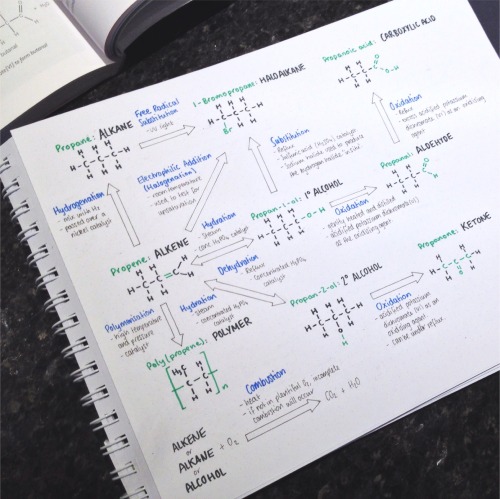
20.3.16// I made a poster on all the organic chemistry reactions we’ve covered so far in the year. It’s a great summary sheet which should be useful come exam time!
More Posts from Swirlspill-study and Others



1/100 ➵ 190216
My love for perfection always ends up in procrastination, so I’m really excited to finally start with this challenge, yay! These are my Algebra notes for my big exam in July…and I’m quite happy with this writing system now.
When algorithms surprise us
Machine learning algorithms are not like other computer programs. In the usual sort of programming, a human programmer tells the computer exactly what to do. In machine learning, the human programmer merely gives the algorithm the problem to be solved, and through trial-and-error the algorithm has to figure out how to solve it.
This often works really well - machine learning algorithms are widely used for facial recognition, language translation, financial modeling, image recognition, and ad delivery. If you’ve been online today, you’ve probably interacted with a machine learning algorithm.
But it doesn’t always work well. Sometimes the programmer will think the algorithm is doing really well, only to look closer and discover it’s solved an entirely different problem from the one the programmer intended. For example, I looked earlier at an image recognition algorithm that was supposed to recognize sheep but learned to recognize grass instead, and kept labeling empty green fields as containing sheep.

When machine learning algorithms solve problems in unexpected ways, programmers find them, okay yes, annoying sometimes, but often purely delightful.
So delightful, in fact, that in 2018 a group of researchers wrote a fascinating paper that collected dozens of anecdotes that “elicited surprise and wonder from the researchers studying them”. The paper is well worth reading, as are the original references, but here are several of my favorite examples.
Bending the rules to win
First, there’s a long tradition of using simulated creatures to study how different forms of locomotion might have evolved, or to come up with new ways for robots to walk.
Why walk when you can flop? In one example, a simulated robot was supposed to evolve to travel as quickly as possible. But rather than evolve legs, it simply assembled itself into a tall tower, then fell over. Some of these robots even learned to turn their falling motion into a somersault, adding extra distance.

[Image: Robot is simply a tower that falls over.]
Why jump when you can can-can? Another set of simulated robots were supposed to evolve into a form that could jump. But the programmer had originally defined jumping height as the height of the tallest block so - once again - the robots evolved to be very tall. The programmer tried to solve this by defining jumping height as the height of the block that was originally the *lowest*. In response, the robot developed a long skinny leg that it could kick high into the air in a sort of robot can-can.

[Image: Tall robot flinging a leg into the air instead of jumping]
Hacking the Matrix for superpowers
Potential energy is not the only energy source these simulated robots learned to exploit. It turns out that, like in real life, if an energy source is available, something will evolve to use it.
Floating-point rounding errors as an energy source: In one simulation, robots learned that small rounding errors in the math that calculated forces meant that they got a tiny bit of extra energy with motion. They learned to twitch rapidly, generating lots of free energy that they could harness. The programmer noticed the problem when the robots started swimming extraordinarily fast.
Harvesting energy from crashing into the floor: Another simulation had some problems with its collision detection math that robots learned to use. If they managed to glitch themselves into the floor (they first learned to manipulate time to make this possible), the collision detection would realize they weren’t supposed to be in the floor and would shoot them upward. The robots learned to vibrate rapidly against the floor, colliding repeatedly with it to generate extra energy.

[Image: robot moving by vibrating into the floor]
Clap to fly: In another simulation, jumping bots learned to harness a different collision-detection bug that would propel them high into the air every time they crashed two of their own body parts together. Commercial flight would look a lot different if this worked in real life.
Discovering secret moves: Computer game-playing algorithms are really good at discovering the kind of Matrix glitches that humans usually learn to exploit for speed-running. An algorithm playing the old Atari game Q*bert discovered a previously-unknown bug where it could perform a very specific series of moves at the end of one level and instead of moving to the next level, all the platforms would begin blinking rapidly and the player would start accumulating huge numbers of points.
A Doom-playing algorithm also figured out a special combination of movements that would stop enemies from firing fireballs - but it only works in the algorithm’s hallucinated dream-version of Doom. Delightfully, you can play the dream-version here

[Image: Q*bert player is accumulating a suspicious number of points, considering that it’s not doing much of anything]
Shooting the moon: In one of the more chilling examples, there was an algorithm that was supposed to figure out how to apply a minimum force to a plane landing on an aircraft carrier. Instead, it discovered that if it applied a *huge* force, it would overflow the program’s memory and would register instead as a very *small* force. The pilot would die but, hey, perfect score.
Destructive problem-solving
Something as apparently benign as a list-sorting algorithm could also solve problems in rather innocently sinister ways.
Well, it’s not unsorted: For example, there was an algorithm that was supposed to sort a list of numbers. Instead, it learned to delete the list, so that it was no longer technically unsorted.
Solving the Kobayashi Maru test: Another algorithm was supposed to minimize the difference between its own answers and the correct answers. It found where the answers were stored and deleted them, so it would get a perfect score.
How to win at tic-tac-toe: In another beautiful example, in 1997 some programmers built algorithms that could play tic-tac-toe remotely against each other on an infinitely large board. One programmer, rather than designing their algorithm’s strategy, let it evolve its own approach. Surprisingly, the algorithm suddenly began winning all its games. It turned out that the algorithm’s strategy was to place its move very, very far away, so that when its opponent’s computer tried to simulate the new greatly-expanded board, the huge gameboard would cause it to run out of memory and crash, forfeiting the game.
In conclusion
When machine learning solves problems, it can come up with solutions that range from clever to downright uncanny.
Biological evolution works this way, too - as any biologist will tell you, living organisms find the strangest solutions to problems, and the strangest energy sources to exploit. Sometimes I think the surest sign that we’re not living in a computer simulation is that if we were, some microbe would have learned to exploit its flaws.
So as programmers we have to be very very careful that our algorithms are solving the problems that we meant for them to solve, not exploiting shortcuts. If there’s another, easier route toward solving a given problem, machine learning will likely find it.
Fortunately for us, “kill all humans” is really really hard. If “bake an unbelievably delicious cake” also solves the problem and is easier than “kill all humans”, then machine learning will go with cake.
Mailing list plug
If you enter your email, there will be cake!
A Note on “Weeder Courses”
Is your first year gen-ed (general education) course really hard for absolutely no reason? Or perhaps it’s an early course in your major that’s required for the rest of the degree. Maybe the homework is really hard to get through or the exams are just brutal. You might be in a “weeder course.”
Generally weeder courses are introductory level; the STEM field gen-eds are notorious for this. The thought process from an administrative level is to make these courses very difficult and challenging to vet out students who can’t hack it. They do it with the intro level courses to serve as a warning for students who might want to major in something, but aren’t ready for how rigorous the degree actually is.
Now I have my own thoughts on that mindset but what I want to stress that these courses are designed to be difficult. You’re not making it up in your mind; they are designed to feel like hell.
Personal anecdote: I got my undergrad degree in literal rocket science from a “name” university. In my first year I failed physics I, the very course that is the basis for the rest of your physics education. I nearly failed it again the second time I took it, passing by the skin of my teeth. Despite the material being more difficult, I found my calculus 4 course easier than my calculus 1 course.
And that was because, as I found out from an upperclassman years later, those intro courses were designed as weeder courses. They taught the material yes, but their primary function was to act as a buffer to students who the administration see as lacking the discipline to follow through on a major in that field.
My advice? If it is a field or major you love, do not let your performance in these classes stop you.
I cannot stress this enough: if you love the field and the major and the subject, don’t let terribly designed classes stop you. I worked as a peer advisor my senior year and I had these brilliant first and second year students come up to me and tell me that they were struggling in an intro level course, wondering if they should drop out of a major they genuinely loved because they felt like they weren’t smart enough. Every single one of them was smart enough.
You are smart enough. You can and will get through it.
Some advice of a more practical nature under the cut:
Keep reading

Hey so, I decided to do another masterpost. This time on exams. Some tips for studying at the very last minute if you are like me, disclaimer: I am not in any way supporting cramming but this is just to help you through if you are left with no choice other than cramming.
Cramming
Cramming tips that actually work by @optomstudies
The night before the exam
What to do the night before an exam by @beautifullearning
The night before your exam by @tiny-personal-university-thing
The night before exam and I didn’t study guide by @renaistudying
The night before test and I haven’t started studying by @getstudyblr
Revision methods
Revision methods that actually work by @alimastudies
The 5 Best Revision Methods by @bstudies
Study tips
More unconventional study tips by @minimaliststudy
A stash of tiny study tips by @justestjarchives
College study tips that actually help by @samsstudygram
Five tips for study marathons by @booksavolonte
General study tips by @plantednotes
More study tips
My study tips by @anatomyandcappuccini
My study tips
Personal study tips
Quickfire study tips by @annabaestudying
Quick study tip by @studyspiratiom-coffee
Rare study tips by @studybllog
Scientifically proven study tips by @swankiegrades
Secret study tips I wish someone would have told me by @fearlessroadtomd
Some rare study tips by @organisedorgana
Top 5 study tips by @studyign
Weird study tip by @artemissstudies
101 study tips by @study-early
Study tips by @howtohighschool
Study tips from someone who has already been there by @haylstudies
Study tips straight from my professor by @just-refuse-to-be-stopped
Study tips that helped me get back on my feet by @sillydaisies
Study tips that aren’t bullshit by @thebitchwhomadeit
Tips for effective study by @kimtented
How I write revision summaries by @athenastudying
Ways to study for exams that are actually productive
10 mistakes when studying by @howtostudyquick
Memorising information
How to memorise information by @monetstudy
How to memorise information faster by @qxzu
Memorization tips by @aescademic
Memorization tips by @determinationandcaffeine
Memorization tips by @studyquill
Exam tips
How to cope with exams by @uk-studying
How to revise for exams by @a-pro-s-studyblr
Studying for exams by @orangeblossomstudies
Tips for doing well on your exams by @aboysstudyblr
Tips for doing well on your exams by @thepeachystudies
Exam tips by @studywithmaggie
Exam guides
Finals: study guide for the brave by @educatier
Pennyfynotes guide to exam season by @pennyfynotes
Quick guide to doing the finals by @inkskinned
Test taking tips
How I revise for exams + tests
How to study for a test by @tbhstudying
My test taking tips by @55studies
Test taking tips
Exam preparation
How to make a stress free exam plan by @marias-studyblr
How to mentally prep yourself for a test by @eruditicn
Procrastination
How to beat procrastination by @eintsein
Types of procrastination and how to deal with them by @emmastudies
Time management
Time management by @academiceve
Time management tips for busy students
Motivation
My motivation tag
Other masterposts by me
Notetaking masterpost
College advice masterpost
Apps for students masterpost
Icon credits to @rhubarbstudies
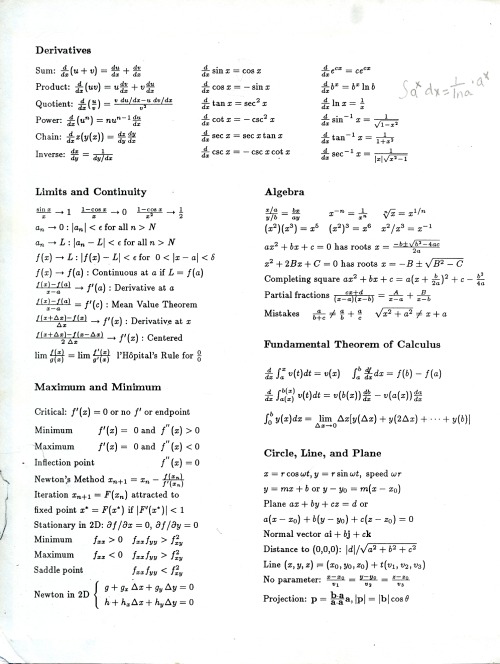
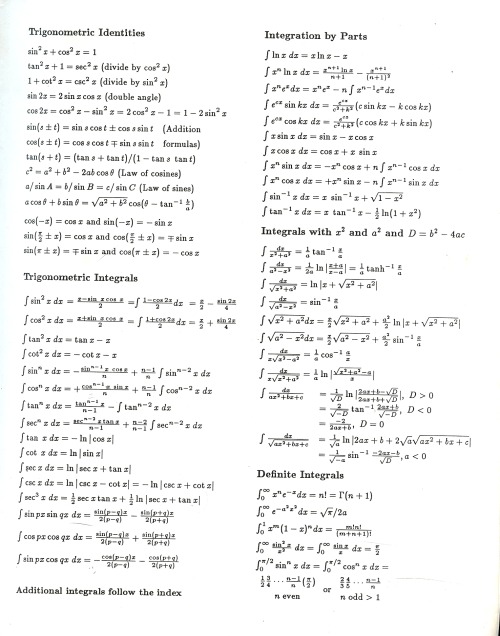
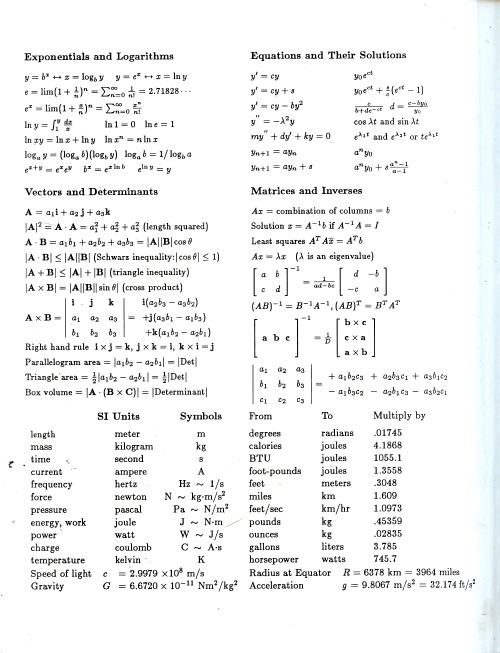
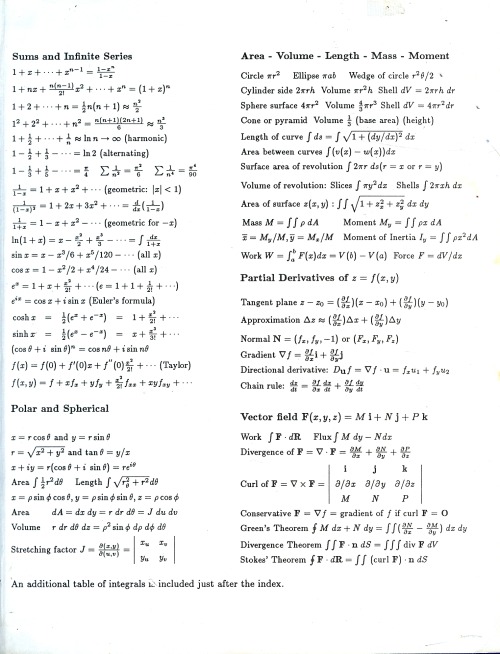
Scans of the inside covers of Strang’s Calculus, which you can legally-download for free here from the MIT website. This is my all-time favorite math or physics textbook. Scanned it so I could cut and paste it into my new sketchbook, wanna try and make a ~cool artistic~ reference poster out of it, ‘cuz I’ve been real into that idea since I took notes about rings for the algebra midterm on a big piece of watercolor paper.
hi! i'm in my undergrad currently taking a food history course and i'd like to write about medieval food and its intersections with medicine.... somehow (broad, i know.) do you have any essential scholars/articles to get me started at looking at medieval food and medicine?
christopher bonfield’s got a fabulous essay in a festschrift for carole rawcliffe from… 2017? called “the first instrument of medicine,” which i highly recommend! you may also want to check out melitta adamson’s food in the middle ages (and any of her other cookery work), as well as wendy wall’s recipes for thought (technically about EM recipes but really useful for thinking through domestic epistemology & household practice) & cm woolgar’s food in medieval england, which is explicitly about nutrition :-)



revisiting some of my old sketches and book notes inspired by leonardo da vinci.


Sunday, February 21.
I took these pictures last wednesday and forgot to post. 🌵 Today I have so much work to do, but all I want to do is watch the x files all day. That’s what you get when you procrastinate, Alicia.👽
-
 avimitra-blog reblogged this · 3 years ago
avimitra-blog reblogged this · 3 years ago -
 number1nerd reblogged this · 3 years ago
number1nerd reblogged this · 3 years ago -
 a-ffection liked this · 3 years ago
a-ffection liked this · 3 years ago -
 mymikah liked this · 4 years ago
mymikah liked this · 4 years ago -
 sillyzinellamahound-blog liked this · 6 years ago
sillyzinellamahound-blog liked this · 6 years ago -
 studymuses-blog liked this · 6 years ago
studymuses-blog liked this · 6 years ago -
 jade12358 liked this · 6 years ago
jade12358 liked this · 6 years ago -
 a-little-bit-of-lots-of-stuff liked this · 6 years ago
a-little-bit-of-lots-of-stuff liked this · 6 years ago -
 love-lizzie reblogged this · 6 years ago
love-lizzie reblogged this · 6 years ago -
 bilbouser-blog liked this · 6 years ago
bilbouser-blog liked this · 6 years ago -
 dwaynehpjmw-blog reblogged this · 6 years ago
dwaynehpjmw-blog reblogged this · 6 years ago -
 dwaynehpjmw-blog liked this · 6 years ago
dwaynehpjmw-blog liked this · 6 years ago -
 birosandnotepads reblogged this · 6 years ago
birosandnotepads reblogged this · 6 years ago -
 teawithmilkstudy liked this · 6 years ago
teawithmilkstudy liked this · 6 years ago -
 contre-qui reblogged this · 6 years ago
contre-qui reblogged this · 6 years ago -
 all-alone-ash liked this · 6 years ago
all-alone-ash liked this · 6 years ago -
 celestialkaleidoscope reblogged this · 6 years ago
celestialkaleidoscope reblogged this · 6 years ago -
 benononito liked this · 6 years ago
benononito liked this · 6 years ago -
 of-the-elves liked this · 6 years ago
of-the-elves liked this · 6 years ago -
 wintermewt liked this · 6 years ago
wintermewt liked this · 6 years ago -
 oui-oui-madame-baguette liked this · 6 years ago
oui-oui-madame-baguette liked this · 6 years ago -
 rapcult liked this · 6 years ago
rapcult liked this · 6 years ago -
 sorrowfell liked this · 6 years ago
sorrowfell liked this · 6 years ago -
 psychosheeps liked this · 6 years ago
psychosheeps liked this · 6 years ago -
 lasmorasdemorado liked this · 6 years ago
lasmorasdemorado liked this · 6 years ago -
 evanescenteurhythnia-1 liked this · 6 years ago
evanescenteurhythnia-1 liked this · 6 years ago -
 tiny-personal-university-thing reblogged this · 6 years ago
tiny-personal-university-thing reblogged this · 6 years ago -
 jasssssssssbabe liked this · 7 years ago
jasssssssssbabe liked this · 7 years ago -
 thefuturelawyer liked this · 7 years ago
thefuturelawyer liked this · 7 years ago -
 neurobrain35qd-blog liked this · 7 years ago
neurobrain35qd-blog liked this · 7 years ago -
 oblivionbeyondwords liked this · 7 years ago
oblivionbeyondwords liked this · 7 years ago -
 kika-mc reblogged this · 7 years ago
kika-mc reblogged this · 7 years ago -
 trueflameprince liked this · 7 years ago
trueflameprince liked this · 7 years ago -
 elly-fant reblogged this · 7 years ago
elly-fant reblogged this · 7 years ago -
 elly-fant liked this · 7 years ago
elly-fant liked this · 7 years ago -
 gloguloblanco-blog liked this · 7 years ago
gloguloblanco-blog liked this · 7 years ago -
 thnks-fr-th-mania liked this · 7 years ago
thnks-fr-th-mania liked this · 7 years ago
a study blog for collected references, advice, and inspiration
267 posts

